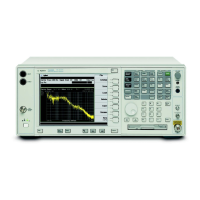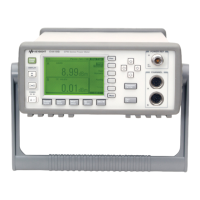180 Chapter 3
Instrument Functions: M - O
Marker Fctn
Instrument Functions: M - O
To measure the ratio of the noise densities at two locations, be sure that the Marker Fctn is
Marker Noise. (The noise is averaged over a region that is 5% of the span, centered at the
marker location.) Select
Marker, Normal before selecting Delta marker. Then move the active
(
∆) marker to the second noise location. In this case both markers have units of noise
density (for example, dBm/Hz), so the data displayed represents the ratio of the noise
density at the delta marker to the noise density at the reference marker. The value readout
is displayed as a ratio (dB or %).
To guarantee accurate data for noise-like signals, a correction for equivalent noise
bandwidth is made by the analyzer. The
Marker Noise function accuracy is best when the
detector is set to
Average or Sample, because neither of these detectors will peak-bias the
noise. The trade off between sweep time and variance of the result is best when
Avg/VBW
Type
is set to Power Averaging. Auto coupling, therefore, normally chooses the Average
detector and
Power Averaging. Though the Marker Noise function works with all settings of
detector and
Avg/VBW Type, using the positive or negative peak detectors gives less
accurate measurement results.
Key Path:
Marker Fctn
Dependencies/
Couplings:
Video triggering is not available when the detector is Average, therefore
marker functions that would set the detector to
Average, and thus conflict
with video triggering, are not available when the
Video trigger is On.
Remote Command:
See “Marker Fctn” on page 179 for the command to select a function.
Remote Command Notes: Note that the value when the Y-axis units are watts is the
square of the value when the Y-axis units are volts. For example, when the
percent ratio with Y-axis units in volts is 20% (0.2), the percent ratio with
Y-axis units in watts will be 4% (0.2
2
= 0.04). When you read the value out
remotely you have to know whether you are in log (dB) or linear (percent),
and if linear, whether volts or watts.
Example: CALC:MARK:FUNC NOIS turns on marker 1 as a noise marker.
CALC:MARK:FUNC? returns the current setting of marker function for the
marker specified. In this case it returns the string: NOIS.
CALC:MARK:Y? returns the y-axis value of the
Marker Noise function for
marker 1 (if
Marker Noise is ON for marker 1).

